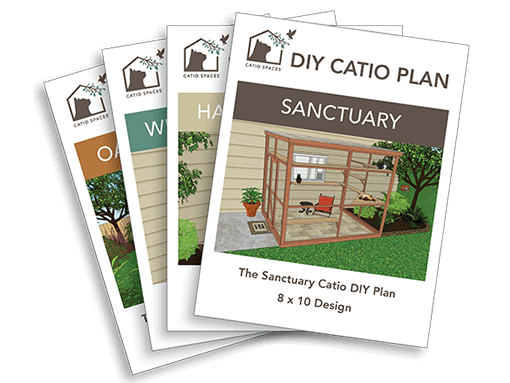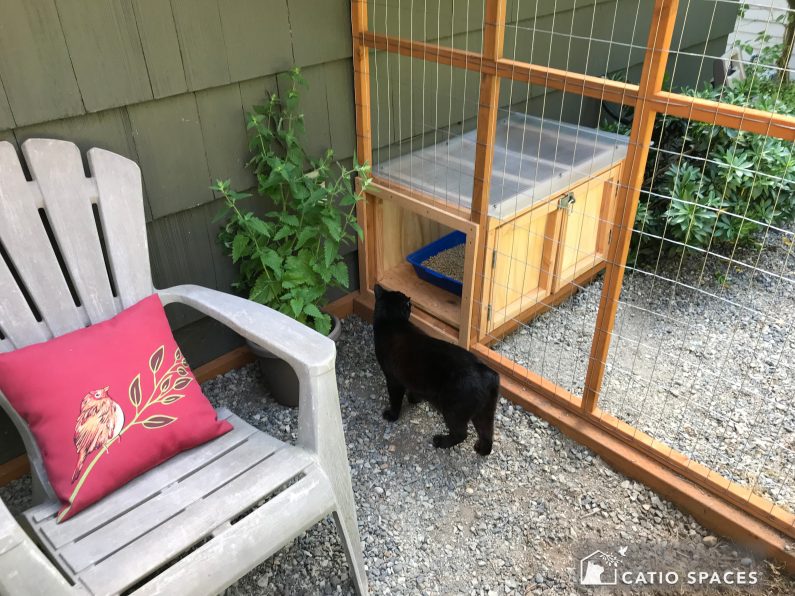
When you enrich your cat’s life with a catio, you gift them with even more space for all the things that are essential to their happy, fulfilled life. And let’s face it: roomy, comfortable, and private litter boxes (yes, more than one!) are right up there at the top of the list for feline needs.
Giving your cat a choice is incredibly important when it comes to preventing feline house soiling accidents. Why not add a litter box to your cat’s catio haven? Let’s look at all the things “litter box” from the perspective of your cat!
5 GREAT REASONS TO ADD A LITTER BOX TO YOUR CATIO
1. A litter box outdoors in the fresh air helps reduce odor-producing waste inside your house, especially during warm, humid weather. Because it is an EXTRA box – not a replacement for one of your inside boxes – your feline family will make fewer visits to indoor litter areas.
2. Litter box competition is a major stressor in multi-cat households. An additional catio litter box means cats have more options if one cat is stationed by another box, ready to pounce.
3. Your privacy-loving cat has a quiet place to “go” when there are high-energy visitors, rambunctious children, or power-tool-worthy projects inside your house.
4. When your senior or mobility-impaired cat gets that urge, they don’t have to interrupt their sun-bathing or birdwatching to travel all the way back into the house.
5. If you and your cat are enjoying the beauty of your catio and garden together, your feline companion doesn’t have to leave your side for a bathroom break.
With a water bowl, outdoor stimulation, comfy resting spots (and you!), your catio has everything your cat needs to enjoy the catio lifestyle.
WHICH LITTER BOX DIY PLAN IS BEST FOR YOUR CATIO?
Our catio-loving clients asked for litter box options, and Catio Spaces couldn’t help but answer with two new DIY Plans – the Catio Litter Box and Litter Box Bench. With our easy-to-build DIY plans, your catio becomes the purr-fect place to include a litter box for more choices and less stress to your cat’s life.
The Catio Litter Box DIY Plan
• The space-saving litter box is secured outside of your catio.
• A flexible plan allows mounting the litter box on either side.
• Exterior doors provide easy access for cleaning.
• Fits a large, 18” x 24” litter box for single or multiple cats.
• Wood can be stained or painted to complement your catio.
• Polycarbonate roof provides a light-filled space.
• An attractive and functional addition to a catio of any size.
Learn more about the Catio Litter Box DIY Plan >>
The Litter Box Bench DIY Plan:
• The multi-function litter box has feline and human seating.
• Front doors provide easy access for cleaning the litter box.
• Flexible cat entry options from the left or right side (or both).
• No cat door is required with 1 or 2 open sides.
• Fits a large, 18” x 24” litter box for single or multiple cats.
• Wood can be painted or stained, plus your fabric choice.
• Ideal for use in a catio or inside your home.
Learn more about the Litter Box Bench DIY Plan >>
Both DIY catio litter boxes help eliminate indoor litter odors and reduce stressful litter box competition in multi-cat homes. In addition, you can stain or paint them to complement your catio décor, and each provides your cat an outdoor litter box convenience to enjoy the catio lifestyle.
CHOOSING A LITTER BOX & TYPE OF LITTER FOR YOUR CAT
Your home’s human bathroom is most enjoyable when it’s clean, comfortable, and attractive – however the perfumed potpourri one person may love, another person may find oppressive. Cats also have individual restroom preferences.
One thing cat experts agree on: You should always have at least one more litter box than you have cats to provide options and reduce competition in multiple cat households. Some cats even prefer to urinate in one box and defecate in another.
Let’s take a deeper look into the long list of available litter boxes and litter options.
8 common litter box types and some of their pros and cons.
- Pros: The usual medium-sized litter box and scoop that new cat parents purchase as a starter box is economical and fits conveniently into out-of-the-way locations humans prefer.
- Cons: Medium to large cats may feel cramped or hang their furry bottoms over the side, resulting in out-of-box accidents. The sides are low, so you may have litter scattered about if your cat enjoys digging.
2. Extra Large (uncovered)
- Pros: An extra-large box provides room for big cats. Cats who prefer to step around clumps also appreciate the extra space. Cats feel safer because they can see all around.
- Cons: It takes up more space and the higher sides may be difficult for kittens and senior cats to navigate.
- Pros: Keeps litter and odors in the box and hides the contents from human view. They are available in many different configurations, from modern to ornamental.
- Cons: Odors confined in the box may be overwhelming to your cat. Your cat may be reluctant to use a box where they feel trapped. Because the contents are out of sight, you may forget to clean the box every day.
Catio Litter Box Tip: A covered box won’t be needed with our DIY Catio Litter Boxes since they enclose and protect the box while also allowing air movement.
- Pros: Reduces daily scooping responsibilities and can be a helpful aid for cat parents who cannot bend to clean a traditional box.
- Cons:Transitioning your cat to a new litter box may take several days to a week, depending on their comfort level. Cats can be startled by noises that the new box makes. Electronic litter boxes can be expensive, especially for households with multiple cats and litter boxes.
Catio Litter Box Tip: Indoor electrical litter boxes are not recommended for outdoor use.
- Pros: Helps keep litter, feces, and urine in the box, especially for cats who defecate over the side of a regular box or who spray when they urinate.
- Cons: Some cats don’t like being enclosed by high sides, especially if another cat in the household likes to ambush the litter box. Senior cats and kittens may find it difficult to jump in and out.
- Pros: Great for kittens, seniors, and mobility impaired cats who find high-sided cat boxes daunting. Easy to enter and exit.
- Cons: The sides are extra low, and litter-kickers can score championship field goals with litter and clumps.
- Pros: Easy to clean – simply discard when the time comes to change the litter. A good option when traveling long distances by cars, for use in hotel rooms, etc.
- Cons: Small in size, expensive to use long-term, and results in more waste than a reusable box.
- Pros: Economical, available in a variety of sizes, and usually has handles. The plastic is often soft enough to cut a U-shaped entrance with a knife or jigsaw if needed.
- Cons: The sides might be too high for some cats. Some brands are made of soft plastic, resulting in clawed scratches where bacteria and odors can grow. You may need to replace this box sooner than a commercial box.
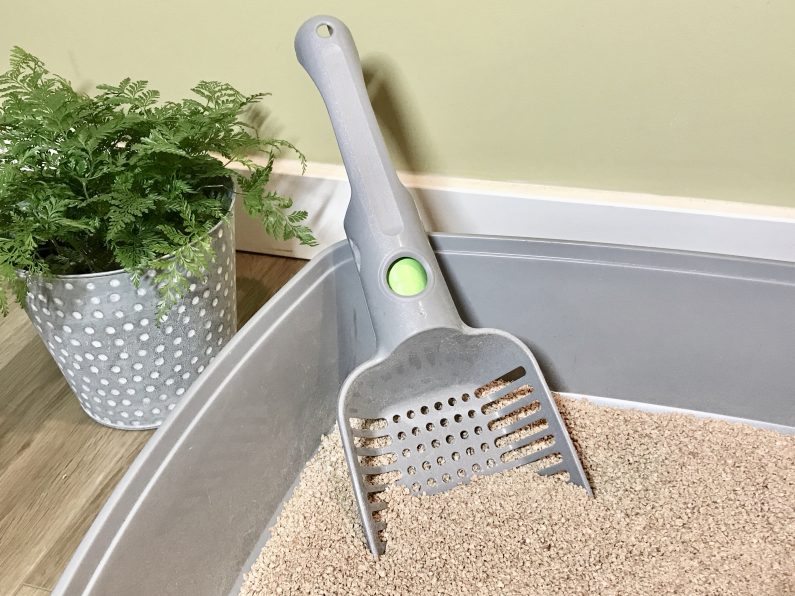
What kind of cat litter is best for you and your cat?
As a cat parent, you’ve probably already encountered various bags, buckets, and boxes of kitty litter products. Here are some quick pros and cons of the different types.
- Traditional clay litter is economical, and most cats use it readily. However, it can be dusty. Because urine is absorbed right into the litter, it needs to be completely replaced weekly to control odor.
- Clumping clay litter is soft to a cat’s paws. Urine solidifies into balls that can be easily removed with a scoop, so it lasts longer than traditional clay. New litter can be added to replace the scooped clumps, extending the time between litter changes to about once a month.
- Plant-based litters made from corn, wheat, grass, or walnut shells have a natural grain-like scent and are biodegradable. If you plan to dispose of the litter outdoors, feces should first be scooped into the regular trash and the litter should be dumped away from gardens and play areas to prevent the spread of parasites that can shed in pet feces.
- Silica gel litter traps urine without having to scoop clumps and has excellent odor control. It is more expensive than clay litter and varies in granule size. Some cats may not like the larger crystals and some brands with small crystals can be dusty.
- Wood litter comes in pellets as well as ground versions. Cat owners like that it is biodegradable and has a natural wood smell, but sensitive cats may find a strong cedar scent off-putting.
- Paper litter is especially useful for cats healing from injury or surgery on their paws or underbody. It is clean, soft, lightweight, dust-free, and fragrance-free. This litter needs to be replaced frequently because it doesn’t clump and is quickly saturated with urine. Lightweight litter can result in accidental box-flipping.
- Scented or unscented? Cat experts tend to agree that cats prefer unscented cat litter. Your cat’s nose is 14 times stronger than a human’s, so a scent we find attractive and mild can be overwhelming to them. Scoop your cat’s boxes daily (twice is optimal) and perfumes won’t be needed. If the box begins to smell even after feces are removed, it’s time to completely replace the litter.
All cats are individuals, so there is no one perfect litter recommendation. However, with multiple litter boxes, you can try several types of litter simultaneously and let your cat choose their favorite.
How deep should the litter be?
Two to three inches is an ideal depth. Your cat will have plenty of litter to cover their waste without feeling like they are sinking into sand dunes. You won’t be wasting litter when the time comes to completely clean the box.
LITTER BOX COMPETITION IN MULTI-CAT HOUSEHOLDS
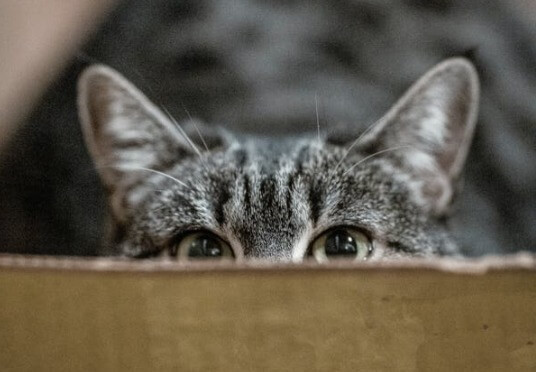
Litter box competition is obvious when one cat pounces the other family felines as they enter or exit a covered box. But it can also be quite subtle, for example when one dominant cat snoozes quietly across the only path to the litter box area, intimidating the other cats when they come by for a bathroom break.
“Competition for shared resources is one of the most common reasons for tension between cats in multi-cat homes and can escalate fast into severe aggression. Increasing and dispersing litter boxes throughout the home can actually decrease territorial thinking between your cats and help them get along better.”
– Mieschelle Nagelschneider, author of The Cat Whisperer, in ModernCat.
It’s important to help cats feel comfortable accessing or leaving their litter box so they don’t resort to relieving themselves in protected corners or behind furniture.
Here are some additional litter box placement tips to reduce stress:
- Place indoor boxes in quiet areas where your cat won’t be alarmed by sudden noises like a washer or dryer.
- Allow plenty of room for escape if your cat becomes startled by humans, noises, or another cat. Avoid closets and tiny bathrooms if you have other options.
- As your cat grows older, a litter box in the basement or upstairs may be a painful and tedious trip. Be sure your senior cat has easy-to-reach litter box options.
- Don’t hide litter boxes completely out of human view where you’ll forget to clean them daily. Set a reminder on your smartphone if the task sometimes slips your mind.
- Don’t reduce your indoor litter boxes if you add an outside catio box. A catio litter box is an extra option that increases your cat’s comfort, not a replacement of familiar indoor litter areas.
Even cats who are currently using their litter box could be approaching a stressful tipping point. By offering multiple boxes in safe locations, your cats will have alternate options to escape visitors, noises, or a competitive feline housemate.
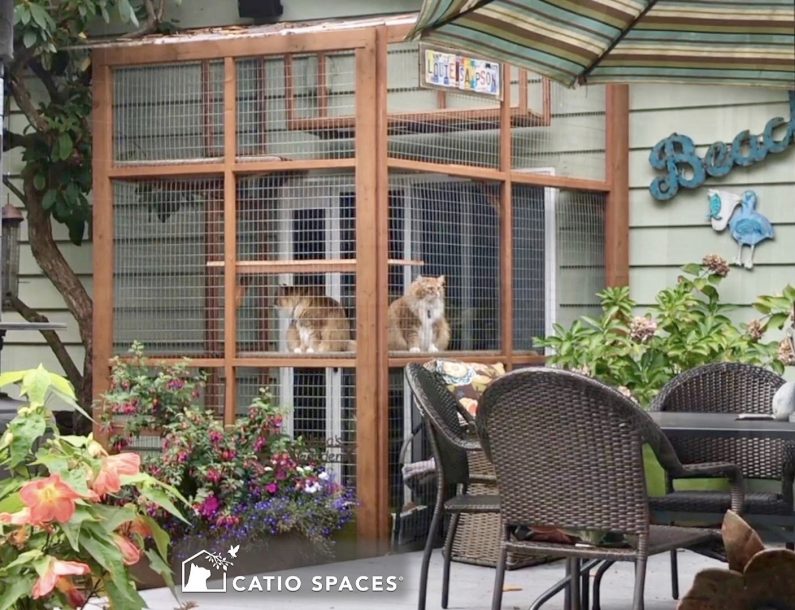
Cats deserve to have a life free of stress and full of love, safety, and enrichment. By adding a litter box to your catio, you help meet your cat’s physical needs as well as their emotional wellbeing.
And, when it comes to both feline necessities and enrichment, life is good in a catio!
DO YOU WANT A CATIO AND OUTDOOR LITTER BOX FOR YOUR CAT?
Check out our variety of DIY Catio Plans for a window, deck, patio, or garden that your cats will love.
LEARN MORE ABOUT OUR DIY CATIO PLANS >>
Catio Spaces has curated our “top picks” for litter box options included in this blog. We participate in the Amazon Services’ affiliate program and earn advertising fees by linking to Amazon.com.

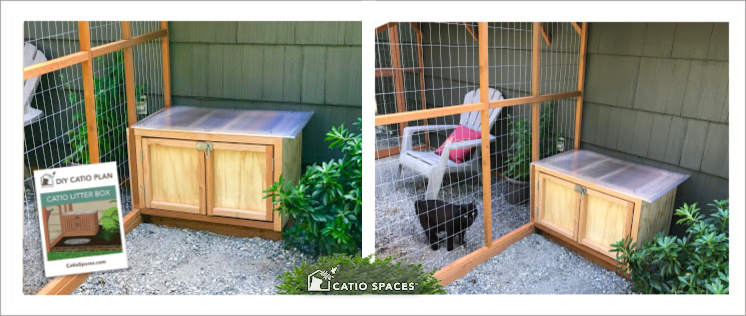
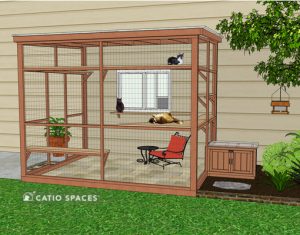
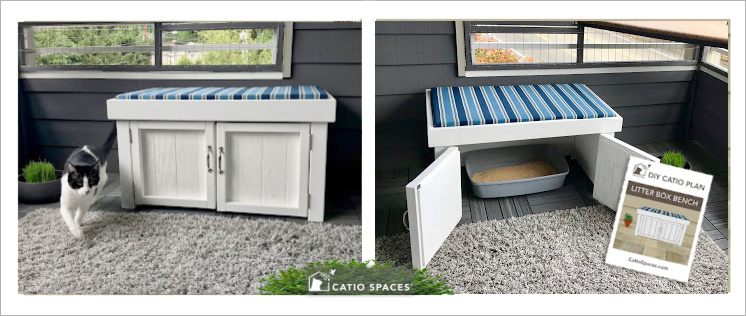
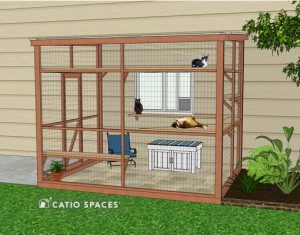
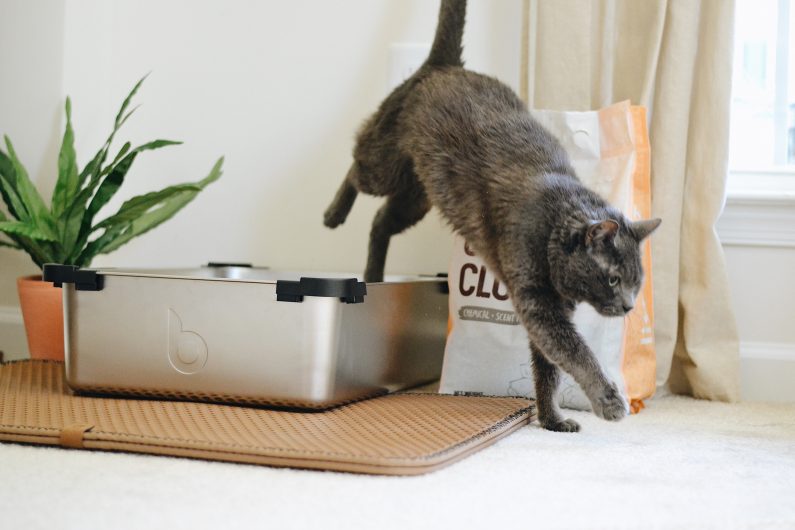
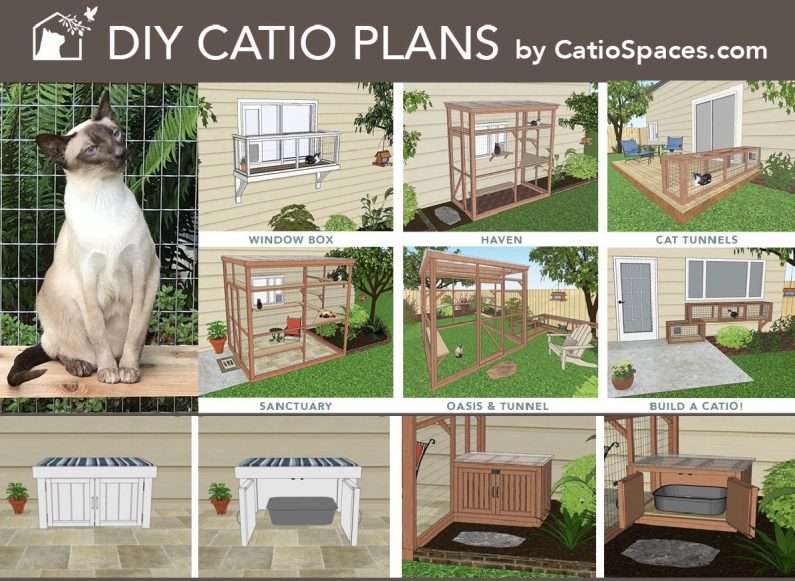

 Cynthia Chomos is a
Cynthia Chomos is a 
